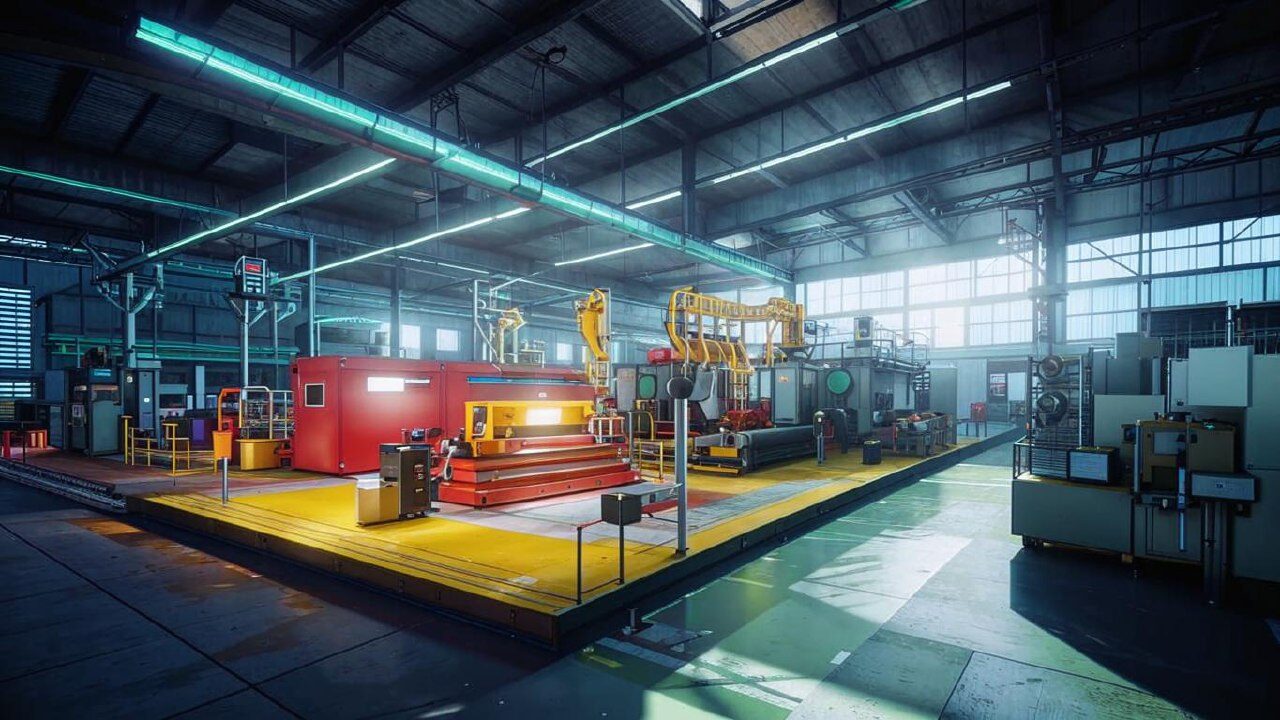
Today Manufacturers are constantly seeking innovative solutions to streamline their processes, reduce waste, and enhance productivity. One such solution gaining traction is Visual Factory Management, a methodology that leverages visual management techniques to improve factory operations and drive efficiency. In this comprehensive guide, we delve into the core concepts of Visual Factory Management and outline strategies for implementing it effectively within your manufacturing facility.
Table of Contents
- Understanding Visual Factory Management
- The Benefits of Visual Factory Management
- Key Visual Management Techniques
- Implementing Visual Factory Management
- Conclusion
Understanding Visual Factory Management
Visual Factory Management is a cornerstone of lean manufacturing principles, focusing on the use of visual tools to optimize factory floor operations. At its core, it aims to provide a clear, visual representation of the production process, enabling real-time monitoring, quick problem identification, and timely decision-making. By incorporating visual indicators and cues, manufacturers can create a highly efficient and organized workspace conducive to seamless operations.
The Benefits of Visual Factory Management
Implementing Visual Factory Management offers a myriad of benefits for manufacturers looking to enhance efficiency and clarity in their operations:
- Improved Workflow Visibility: Visual Factory Management provides unparalleled transparency into the manufacturing process. By utilizing visual tools such as Kanban boards and Andon systems, managers gain real-time insights into workflow status, allowing for better resource allocation and production planning. This enhanced visibility enables timely decision-making and facilitates proactive problem-solving, ultimately leading to smoother operations and increased productivity.
- Enhanced Communication: Effective communication is the cornerstone of any successful manufacturing operation. Visual Factory Management fosters clear and concise communication across all levels of the organization by utilizing visual cues and displays. Whether it's conveying production targets, highlighting quality issues, or signaling maintenance requirements, visual indicators ensure that critical information is communicated quickly and accurately. This promotes alignment, reduces misunderstandings, and fosters a collaborative work environment conducive to high performance.
- Reduced Operational Waste: Waste is the enemy of efficiency in manufacturing. Visual Factory Management helps identify and eliminate various forms of waste, including overproduction, excess inventory, and unnecessary motion. By visually mapping out the production process and identifying inefficiencies, manufacturers can implement targeted improvement initiatives to streamline operations and minimize waste generation. This not only reduces costs but also improves overall resource utilization and sustainability. Trusted by thousands of businesses worldwide, Cleverence empowers you to efficiently track inventory, streamline warehouse operations across multiple locations, effortlessly scan barcodes, and navigate complex manufacturing processes, all within one user-friendly platform. As inventory flows in and out of your operational workflows, Cleverence automatically updates your current system, providing invaluable insights into true landed costs, COGS (Cost of Goods Sold), and cash flow impacts.
- Streamlined Problem-Solving: In manufacturing, problems can arise unexpectedly and disrupt operations if not addressed promptly. Visual Factory Management empowers teams to identify and resolve issues in real-time by providing visual cues and alerts. Whether it's a machine breakdown, quality defect, or supply chain disruption, visual indicators on Andon boards allow operators to signal for assistance and trigger rapid response protocols. This proactive approach to problem-solving minimizes downtime, prevents production delays, and preserves customer satisfaction.
- Increased Employee Engagement: Engaged employees are more productive, innovative, and committed to the success of the organization. Visual Factory Management promotes employee engagement by providing clear expectations, fostering a sense of ownership, and recognizing individual contributions. When employees have a visual representation of their goals, performance metrics, and progress, they are more motivated to strive for excellence and actively participate in continuous improvement initiatives. This creates a culture of accountability, collaboration, and continuous learning, driving organizational success.

Key Visual Management Techniques
1. Kanban Systems
Kanban is a visual scheduling system that originated from lean manufacturing principles. It involves the use of Kanban boards, which visually represent the flow of work through various stages of production. Each stage is represented by columns on the board, and tasks or work items are represented by cards or sticky notes. As work progresses, cards are moved across the board, providing a clear visual indication of the status of each task. Kanban systems enable just-in-time production by signaling when new work should be started based on demand and available capacity.
2. Andon Systems
The Andon system is a visual signaling device used to alert operators and management to production issues or abnormalities in real-time. Typically, Andon systems consist of lights or displays located throughout the factory floor. When a problem occurs, operators can activate the Andon signal, which triggers a visual and/or audible alert. This allows for quick identification and resolution of issues, minimizing downtime and preventing further disruptions to production.
3. Poka-Yoke (Error Proofing)
Poka-Yoke is a technique used to prevent errors or defects from occurring in the production process. It involves the use of visual cues or devices to guide operators and prevent mistakes at the source. For example, using color-coded parts or fixtures to ensure proper assembly, or incorporating sensors to detect abnormalities and trigger alerts. By implementing Poka-Yoke techniques, manufacturers can minimize rework, improve product quality, and enhance overall efficiency.
5S Methodology
5S is a systematic approach to workplace organization and cleanliness, consisting of five key principles: Sort, Set in Order, Shine, Standardize, and Sustain. Each principle is aimed at improving efficiency and safety through visual management techniques:
Eliminate unnecessary items from the workspace to reduce clutter and improve workflow.
Arrange tools, equipment, and materials in a logical and ergonomic manner for easy access and retrieval.
Keep the workspace clean and well-maintained to ensure a safe and efficient working environment.
Establish standardized processes and procedures to ensure consistency and reduce variability in work practices.
Implement measures to sustain the improvements made through 5S over the long term, including regular audits and employee training.
Visual Work Instructions
Visual work instructions provide step-by-step guidance to operators through the use of pictures, diagrams, and videos. Unlike traditional text-based instructions, visual work instructions are easier to understand and follow, reducing the likelihood of errors and improving efficiency. By incorporating visual aids, manufacturers can standardized work processes, facilitate training, and ensure consistent quality across production lines.
Implementing Visual Factory Management
To embark on your Visual Factory Management journey, consider the following steps:
- Assess Current State: Begin by conducting a comprehensive assessment of your current manufacturing processes. This involves analyzing workflows, identifying bottlenecks, and evaluating existing communication channels. Engage key stakeholders, including frontline workers, supervisors, and managers, to gain insights into operational challenges and opportunities for improvement.
- Define Objectives: Clearly define your objectives for implementing VFM. Are you aiming to reduce lead times, improve quality, enhance productivity, or achieve all of the above? Establish SMART (Specific, Measurable, Achievable, Relevant, Time-bound) goals that align with your overall business strategy and objectives.
- Engage Stakeholders: Effective implementation of VFM requires buy-in and collaboration from all levels of the organization. Engage frontline employees early in the process, soliciting their input and feedback on potential visual management techniques. Create cross-functional teams to oversee the implementation process, ensuring representation from various departments and disciplines.
- Select Appropriate Tools: Identify the most suitable visual management tools and techniques for your manufacturing environment. This may include Kanban systems, Andon boards, visual work instructions, 5S methodology, or a combination of these and other techniques. Consider factors such as complexity, ease of implementation, and compatibility with existing systems and processes.
- Invest in Training and Education: Provide comprehensive training and education to employees on the principles and practices of VFM. Ensure that everyone understands their roles and responsibilities in maintaining visual management systems and adhering to standardized processes. Offer ongoing support and resources to facilitate learning and skill development.
- Integrate Technology: Leverage technology, including ERP systems such as SAP or Oracle, to integrate visual management tools seamlessly into your manufacturing operations. Utilize data analytics and real-time monitoring capabilities to track key performance indicators, identify trends, and make data-driven decisions. Ensure that your chosen technology solutions align with your overall VFM strategy and objectives.
- Establish Performance Metrics: Define key performance metrics to measure the effectiveness of your VFM implementation. These may include metrics related to productivity, quality, lead times, inventory levels, and employee engagement. Establish baseline measurements prior to implementation and track progress over time to gauge the impact of visual management initiatives.
Conclusion
Visual Factory Management represents a powerful approach to enhancing clarity and efficiency in manufacturing operations. By leveraging visual management techniques, manufacturers can streamline workflows, reduce waste, and drive operational excellence. Whether you're looking to improve communication, optimize processes, or boost productivity, Visual Factory Management offers a comprehensive roadmap for achieving your manufacturing goals. Embrace the power of visualization and unlock the full potential of your factory floor.
